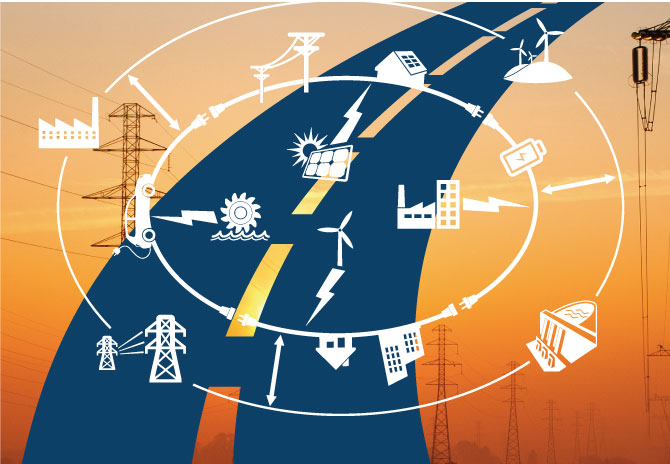Society’s transition to electrification is essential to meet climate targets for 2030 and 2050. This requires increasing the capacity of the power grid—but how can we achieve that?
FME CINELDI developed a strategy and roadmap that outline how to achieve the transition to a flexible and intelligent power grid.
Significant changes ahead
Norway faces a formidable task in adapting its infrastructure to meet increasing energy demands, with electricity consumption expected to rise from today’s 140 TWh to 220 TWh by 2050, according to Norwegian transmission system operator Statnett (in Norwegian).
To achieve electrification and climate neutrality goals, it is crucial to make better use of the existing grid while also facilitating grid expansion. However, this transformation requires more than new cables and substations—it calls for the digitalisation of the power grid and a digital transformation across the industry.
Thirty stakeholders from the power grid industry at large have collaborated to develop the smart power grid of the future, through their involvement in CINELDI, a centre for environment-friendly energy research (FME). Eight years of research, development, and piloting have culminated in a strategy and roadmap that provide a foundation for addressing the complex issues surrounding the power system’s transition.
If grid operators, technology providers, authorities, research scientists, and other industry stakeholders collaborate on the roadmap’s initiatives and take their share of responsibility, achieving a smart and flexible power grid is possible.
Digitalisation and automation: Cornerstones of the future power grid
Operating the future power grid will be more complex than today. Power production will increasingly feature distributed and variable renewable energy sources such as solar and wind. Electricity demand will grow due to the electrification of transport and industry. To manage this complexity, grid control centres will rely on digital solutions providing real-time information to support decision-making and enable more active grid operations. Over time, power flow management in the grid will also be automated.
CINELDI’s results demonstrate how more data from the grid, combined with advanced operational systems, can enhance grid utilisation and improve fault response times. Until new grid infrastructure is built, grid operators can better manage operational risks by using smart meter (AMS) data from end-users to monitor actual consumption and oversee the real load on power lines. Another result from CINELDI shows how grid operators can use automated switching systems, also known as self-healing grids, to handle faults more effectively.
Sensor technology already exists. One example is smart meters (AMS) and sensors that measure actual capacity in power lines (dynamic line rating – DLR). However, integrating these technologies into grid operators’ systems and ensuring the data is used correctly remains a challenge. Standardisation and interoperability are key to addressing this, as data collected in one part of the grid must be exchangeable with neighbouring or overarching networks, ensuring that all operators have consistent decision-making data.
Flexibility enables faster grid connections
Flexibility must be utilised to quickly connect as much new consumption and production as possible, while keeping risk at a level that is acceptable to both grid operators and consumers. Grid expansion, particularly at higher voltage levels, can take years. The demand for electric power capacity exceeds the current grid’s capacity. Flexible solutions—such as controlling end-users’ consumption, for instance by managing EV chargers, and increasing energy storage use—can allow grid operators to connect new customers while awaiting additional capacity. Maximising the efficiency of the existing grid is also important to minimise land use and environmental impact.
Electrification challenges security of supply
Norway currently enjoys exceptionally high security of supply for electricity. However, CINELDI’s research indicates upcoming changes that will challenge this. Factors such as extreme weather, cyberthreats, increased operational stress, and greater system complexity must be addressed in new ways in the future. CINELDI has identified emerging issues and research needs for the future power grid. Our findings show that while digitalisation and flexibility present challenges, they also open new opportunities to enhance security of supply management.

Closer collaboration is the key
Through a comprehensive strategic process involving the entire consortium, CINELDI developed a strategy and roadmap outlining what the entire industry must address to succeed in transitioning to a flexible and intelligent power grid. We must move away from fragmented approaches and a siloed mindset. To achieve their goals, grid companies, technology providers, research institutions, authorities, and other industry stakeholders must work closely together.
Data and model standards, value chains for flexibility, and a risk-based mindset in grid planning and operation must be developed. Regulatory frameworks are also needed to ensure the adoption of flexibility and risk-based operations, making it profitable for the grid industry to digitalise the power grid and its broader operations.
Without closer collaboration within the grid sector, Norway is unlikely to achieve its electrification goals, which are essential for meeting climate targets.












Comments
No comments yet. Be the first to comment!